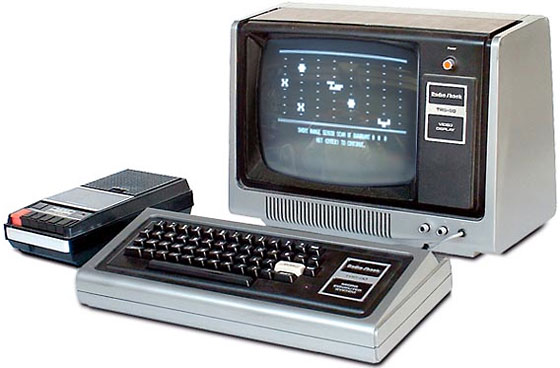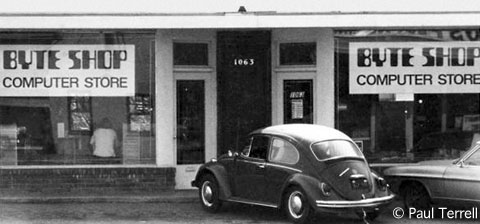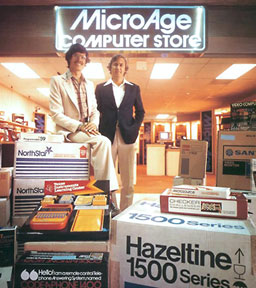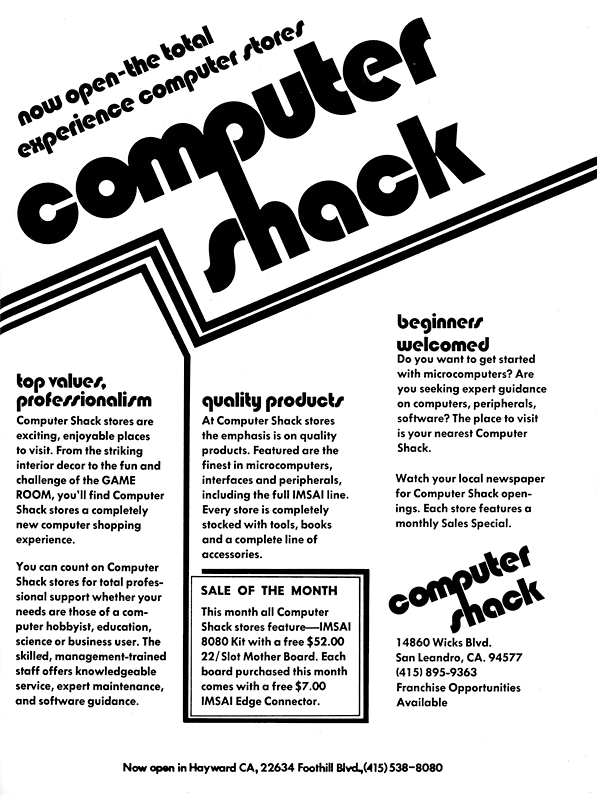Some of you may remember seeing one of the first personal computers at a Radio Shack store in the latter part of 1977. Although there were three competing “home computer” systems on the market, only the TRS-80 was widely available – it was on display at 3,500 Radio Shack stores throughout the United States!

Neither Apple nor Commodore had that kind of exposure. Both companies had to develop their own networks of computer dealers, and the idea of a retail computer store was a new one. A few companies did the work and then built chains of franchise stores using what they had learned in the new market.
MicroAge

Countdown was a popular futuristic typeface in the early days of personal computing, used by Byte Shop and Byte magazine.

Byte Shop, first location.
Founded by Paul Terrell in Mountain View, California, on December 8, 1975 as one of the first retail stores for the fledgling hobby computing market, Byte Shop was the first store to place an order for the Apple 1 computer in 1976. In fact, it was Terrell who convinced Steve Jobs to sell the Apple 1 as an assembled system board rather than a bare logic board that the end user would have to populate and assemble.
 Terrell began franchising Byte Shop locations in January 1976, and it was the largest chain of franchise computer stores for some time. The company later changed its name to MicroAge. The stores typically carried Apple II, IMSAI, Northstar, and Altair computers.
Terrell began franchising Byte Shop locations in January 1976, and it was the largest chain of franchise computer stores for some time. The company later changed its name to MicroAge. The stores typically carried Apple II, IMSAI, Northstar, and Altair computers.
MicroAge was listed on the Fortune 500 list from 1985 through 1991; its chief competitor was ComputerLand. MicroAge filed for bankruptcy in 1991.
ComputerLand
Another the early retail chains was ComputerLand, which was founded by William Millard in 1974 as the first chain of full service computer stores.

January 1977 Computer Shack ad.
Millard had founded IMSAI, maker of one of the earliest kit computers, in 1973, and quickly learned that most computer shops were under-capitalized, which meant they might close their doors at any time and never pay their bills. He needed a more stable way of selling hardware. His solution was Computer Shack, which launched in 1976 and sold assembled IMSAI 8080 computers, along with systems from other manufacturers. Compared with Apple and other brands, the IMSAI hardware did not sell well.
The first franchise store opened in Morristown, New Jersey, in February 1977. After some legal threats from Radio Shack, the name was changed to ComputerLand, and the chain had 14 stores in August 1977, 23 in November 1977, and eventually grew to about 800 locations around the world circa 1985 – still a far cry from Radio Shack’s 3,500 locations.
ComputerLand had a rocky relationship with its franchises, especially when it announced that it wanted to open company stores in franchise markets in the mid 1980s. Between 1984 and 1989, ComputerLand lost 20% of its franchises. Under the leadership of William Tauscher, who stepped into the role in 1988 when ComputerLand’s president and CEO, Kenneth Waters, abruptly quit. Tauscher worked to merge or sell weaker stores and had the corporation acquire many of its big city franchises. In June 1991, Tauscher oversaw the acquisition of Nynex, which added 79 company-owned stores.
This put ComputerLand at odds with it franchisees in a number of locales, which tarnished the brand.
In 1994, ComputerLand sold its name and franchise operation to Merisel, already the largest publicly held wholesaler distributor of microcomputer hardware and software products. The ComputerLand company stores were rebranded under the Vanstar name; Vanstar was acquired by InaCom in 1998.
In 1981, I had the privilege of working at ComputerLand of Grand Rapids (Michigan), the first Apple dealer in the state and one of the early ComputerLand franchises (#44). When I worked there in 1981, the store carried Apple, Atari, Commodore, Osborne, and a few other brands. I remember the day we received our first shipment of IBM Personal Computers in August 1981.
When I returned to ComputerLand of Grand Rapids in 1989, it was selling IBM, NEC, and an unbranded PC clone alongside Novell networking, Great Plains accounting software, and Apple equipment. Coming in as a “DOS dude” at the time, I saw a great opportunity for myself, as everyone else pushed Macs. Instead I became a convert, got my first Mac in 1990, and have never switched from Macs.
I was let go from ComputerLand of Grand Rapids in November 1991, as the company was struggling to survive after our finance company unexpectedly changed our terms. We had closed our Kalamazoo, MI, store earlier in the year, and that November everyone who wasn’t in commissioned sales or the service department was let go. The store lasted a few more months before closing its doors.
Other Retail Chains
There were three other major players in the era of the home computing revolution – Businessland, Nynex, and ValCom – as well as some smaller retail chains.
Businessland
Launched in 1982, Businessland, which did not franchise, was the leading non-franchise retail chain in the industry. In March 1989, it became the only chain of retail stores authorized to sell NeXT Computers. However, Businessland suffered some serious reversals, including losing Compaq – then the third-biggest brand in the industry after IBM and Apple – from its stores in 1989. In 1991, Businessland agreed to be acquired by JWP Inc.
ValCom Inc. was another later player in personal computer retailing, founded by William “Bill” Fairfield in 1982. ValCom and Inacomp Computer Centers merged as InaCom Corp. in 1991, and in 1993 InaCom acquired Sears Business Centers, bringing the chain to over 1,200 locations. ValCom acquired Vanstar in 1998, which unbalanced its finances, leading to ValCom filing for bankruptcy in 2000 and letting go all its employees. Compaq acquired ValCom’s distribution business and other major assets in 2000 and was itself acquired by Hewlett Packard in 2002.
Nynex was a small player, with a total of 79 stores when it was acquired by ComputerLand in 1991, which was in turn acquired by InaCom in 1998.
I don’t know what happened to the Entré Computer chain, which appears to have begun in 1983.
CompuCom Systems was part of the next wave of retail computer chains, starting out in 1987. In 2000, it acquired MicroAge Technology Services. CompuCom appears to be completely out of the retail sector.
The Name Remains the Same
Many former independent ComputerLand franchises continue to use the ComputerLand name. There are still many Entré Computer Centres. The rest of the names of these retail computer chains seem to have vanished into history.
Further Reading
- Whatever Happened to the Corner Computer Store?, Bloomberg, 1991.05.20
MicroAge
- The Byte Shop, PC Museum
- The Byte Shop Opens, This Day in Tech History
- Behold, Some of the First Apple Computer Photos Ever, Time, 2012.11.22
- History of MicroAge, Inc., Funding Universe
ComputerLand
- History of ComputerLand, Funding Universe
- 14 ComputerLand Stores Already Opened, August 1977, old-computers.com
Businessland
- Businessland’s Life Without Compaq, The New York Times, 1989.05.28
- Businessland Endorses Takeover for $54 Million, The New York Times, 1991.06.05
Other
- InaCom Corporation History, Funding Universe
Keywords: #microage #computerland #businessland
Short link: https://goo.gl/ZAXqhz

